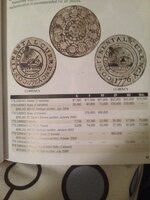Hey Guys,
This is my first post here on Treasure Net. After the passing of my grandfather I received his rather large coin collection. Out of interest I am checking to see the authenticity of most of his coins, and the Continental "Curency" coin caught my attention. I know little to nothing about this coin other than what I've quickly internet searched. If any of you have any info, I would appreciate it greatly. Thanks!
imgur: the simple image sharer
imgur: the simple image sharer
This is my first post here on Treasure Net. After the passing of my grandfather I received his rather large coin collection. Out of interest I am checking to see the authenticity of most of his coins, and the Continental "Curency" coin caught my attention. I know little to nothing about this coin other than what I've quickly internet searched. If any of you have any info, I would appreciate it greatly. Thanks!
imgur: the simple image sharer
imgur: the simple image sharer






